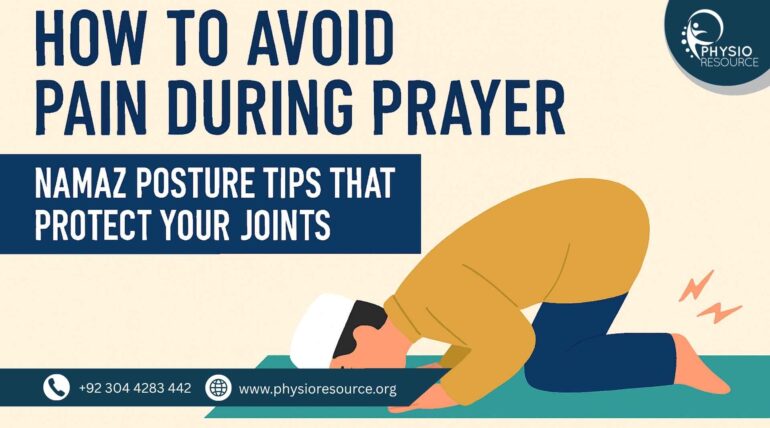
Namaz Posture Tips That Protect Your Joints
No doubt, Namaz is a wonderful practice; however, wrong posture and weak muscles can make your knees, back, feet, and shoulders sometimes painfully active. Many people are under the impression that it’s just a matter of age, and hence they say “ye to age ka masla hai”, but in fact, pain during Namaz is NOT normal. The human body is made to move in prayer positions without any pain; however, inadequate muscle strength, arthritis, tight hips, and wrong alignment create pressure on joints.
Are you experiencing pain in the knees when performing Tashahhud? Or perhaps you are suffering from lower back pain when leaning for Rukoo? Or do you feel ankle/foot pains while sitting between the two Sajdahs? This guide will instruct you on easy posture tips for Namaz, how to protect your joints, and when to seek physiotherapy. This blog is specifically for PhysioResource – The Best Physiotherapy Clinic in Gulberg Lahore – which provides advanced pain relief and posture correction treatments for musculoskeletal disorders.
What Are the Reasons for Pain During Prayer?
Namaz consists of repetitive movements such as standing, bowing, sitting, and prostration.
When your muscles are weak or stiff → your joints carry extra load → pain begins.
Most Common Physical Issues that cause pain during Namaz:
- Weak quadriceps (thigh muscles)
- Tight hamstrings and calves
- Weak core leading to back pain
- Knee osteoarthritis
- Flat feet resulting in more pressure on ankle and knee
- Poor sitting posture
Namaz Posture Tips That Minimize Pain
1) During Ruku:
Maintain a straight spine, bend at the hips rather than the upper back, and contract the abdominal muscles.
2) During Sajdah:
Knees must be soft on the ground, sudden pressure must be avoided, and weight must be evenly distributed.
3) During Sitting:
If pain in the knee becomes unbearable while sitting on the heels, sit cross-legged gently or put a small pillow under your hips.
4) During Standing:
Feet should be apart at shoulder width, weight balance should be equal, and knees should not be locked.
Get solution: Best Poor Posture Treatment in Lahore
Home Exercises that are Helpful
- Strengthening of quadriceps
- Stretching of calf muscles
- Gluteal bridges
- Exercises for core activation
- Stretching of hip flexors
These movements make support for Namaz and take off the burden.
Physiotherapy Benefits
Best Physiotherapist in Lahore at PhysioResource, we uproot the pain during prayer:
- Movement of the joints
- Rebalance muscles
- Treatment through pain relief methods
- Dry needling (if necessary)
- Giving Namaz posture training on an individual basis
- A program of strength & flexibility
Schedule your appointment now!
Prayer pain is not a condition that one should simply “live with” or overlook. It signals that the body needs support, correct alignment, and strengthening. Make an Appointment today at:
Physio Resource – The Best Physiotherapy Clinic in Gulberg Lahore
to enjoy the luxury of praying daily without pain and in complete comfort.
Physio Resource
Phone No: 0304-4283442
Address: 93-A1, Gurumangat Road, Gullberg, III Lahore
Author Dr. Ahmad Bilal
Best Physiotherapist of musculoskeletal conditions with a wide range of skills and a lot of experience, especially in knee pain, back pain, and rehabilitation. He uses an evidence-based and result-oriented approach in clinical practice. Dr. Ahmad Bilal is regarded as the best physiotherapist in Lahore for the treatment of posture-related pain.
Written by: Dr. Ahmad Bilal (Consultant Physiotherapist – MS NMPT)


